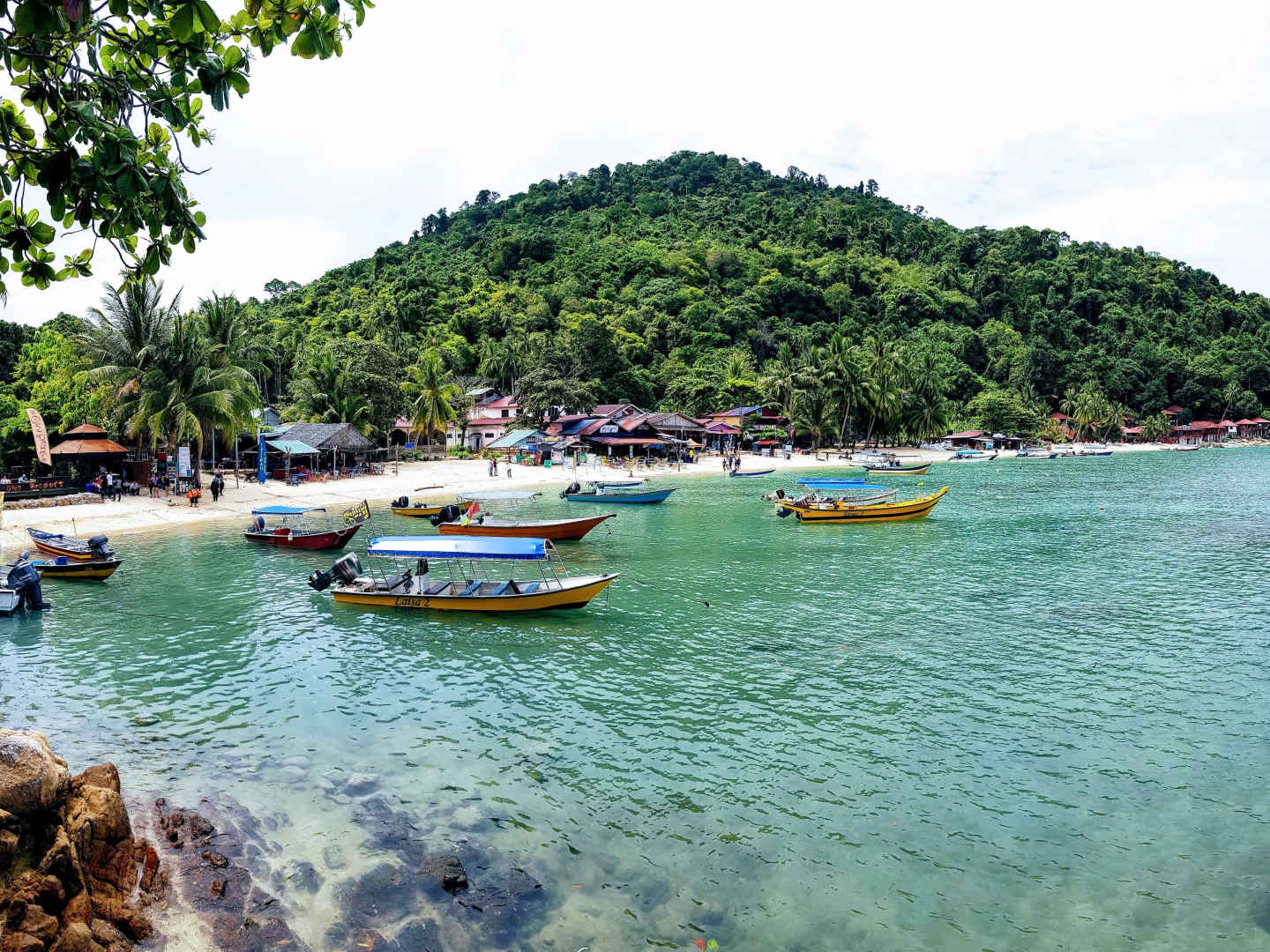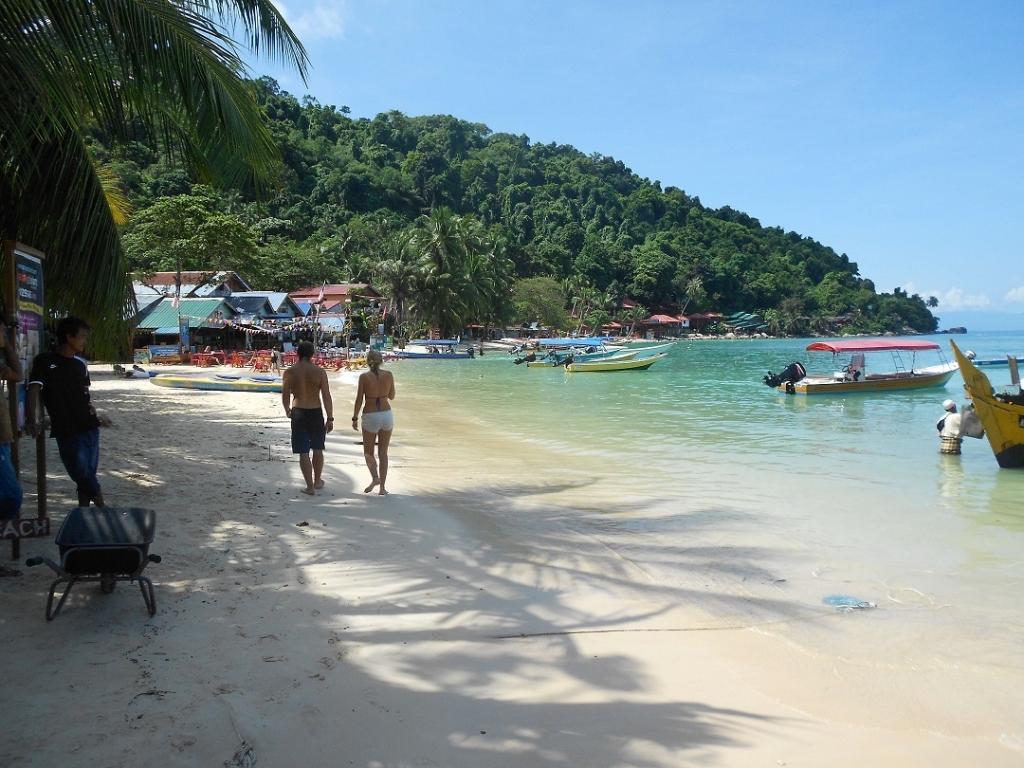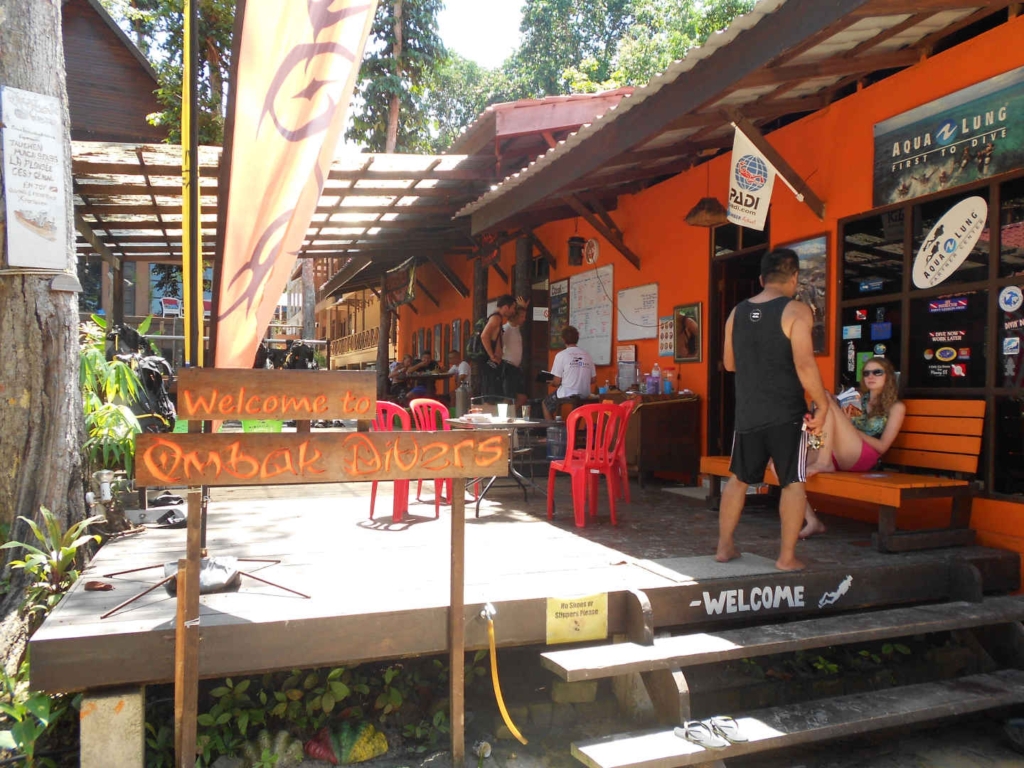The Perhentian Islands off the northeastern coast of Malaysia are a tropical paradise of crystal-clear sea, idyllic beaches and world-class diving. This is an incredible place to learn to dive – I went here as part of my 3 week Malaysia itinerary to do my PADI. I was blown away by the marine life, including sea turtles, reef sharks and coral reefs. However, the islands are only open part of the year, making timing absolutely crucial for your visit. Read on to find out the best time to go to the Perhentian Islands and everything you need to know before you arrive.
This post may contain affiliate links. That means, if you make a purchase, I may receive a small commission. As an Amazon Associate I earn from qualifying purchases. For more information, read my disclaimer.
Quick overview of the Perhentian Islands
- Go from March to October – July-August is peak season
- Avoid to November-February, as the islands are closed for monsoon season
- Get there by bus from Kuala Lumpur or fly to Kota Bharu airport
Introduction to the Perhentian Islands
Pulau Perhentian Kecil, meaning Small Perhentian island, sits next to her big sister Pulau Perhentian Besar in the South China Sea, off Malaysia‘s North-Eastern coast. ‘Perhentian’ means ‘stopping point’ in Malay, referring to the islands’ historically useful positioning for traders operating between Thailand and Malaysia. While the Perhentian Islands are on the backpacker trail, they are still less developed than other islands in Malaysia.
Buy Lonely Planet’s essential travel guide book for Malaysia here.
When is the best time go to the Perhentian Islands?
The best (and only) time to visit the Perhentian Islands is from March to October, as between November and February they are closed to tourists for monsoon season.
The best time to visit is between May and September when you’ll have the most reliable weather and calmest seas. June to August is peak season with higher accommodation prices.
In March and April, the weather can still be unpredictable with occasional rough seas from the tail end of monsoon season. That said, I went in April, and the weather was lovely and the diving conditions were perfect.
Perhentian Kecil or Perhentian Besar?
One of the most important decisions you’ll make when visiting the Perhentian Islands is which island to stay on. I stayed on Perhentian Kecil and can share what I learned about both islands to help you choose.
Perhentian Kecil, where I spent my time, is the backpacker hub of the two islands. This is where you’ll find budget accommodation and a more sociable atmosphere. If you’re travelling solo or on a tight budget, Perhentian Kecil is probably your best bet.
Perhentian Besar caters more to couples, families and those seeking a quieter experience. The accommodation tends to be more upmarket, the beaches are less crowded and the overall vibe is more peaceful. If you’re looking for a romantic getaway or simply want to disconnect completely, Perhentian Besar would be the recommendation.
The good news is that water taxis run between the islands, so you can easily visit the other island for a day trip if you want to experience both during your stay.
How to plan your Perhentian Islands trip
Before you fall in love with the idea of this tropical paradise, there are some practical realities you need to understand about visiting the Perhentian Islands that might influence your travel plans.
Firstly, the islands operate on a seasonal schedule that’s non-negotiable. The Perhentian Islands are closed from November to February due to monsoon season. Plan your trip between March and October, with the peak season being June through August when weather is most reliable.
The cost of staying on the Perhentian Islands is higher than in mainland Malaysia. Everything has to be brought over by boat, which drives up prices for accommodation and food. However, it’s still affordable by Western standards.

How to get to the Perhentian Islands
If you are arriving from Kuala Lumpur like me, the cheapest and most convenient way to get to the Perhentian Islands is to catch an overnight bus. Perdana Express and Mahligai Express operate daily buses on this route, which costs only $12 and takes 7-8 hours. It’s best to buy a ticket in advance. The bus departs from Terminal Bersepadu Selatan in KL and arrives at the Kuala Besut bus terminal.
Alternatively you can find cheap flights to Kota Bharu airport, which is the airport closest to the Perhentian Islands. You can fly directly to Kota Bharu from Kuala Lumpur and Penang with Malaysia Airlines and other carriers. From this airport, it’s a one-hour taxi or bus ride to the Kuala Besut bus terminal.
The staff at the bus terminal will then guide you the short walk to Kuala Besut jetty to board a boat to the islands. Arriving on Pulau Perhentian Kecil, the boat will dock at the small jetty on the beautiful Coral Bay.
While flying to Kota Bharu is the quickest option, many budget travellers prefer the overnight bus from Kuala Lumpur as it’s much cheaper and you save on a night’s accommodation. The choice depends on your budget and how much time you have available for your Malaysia trip.
Where to stay on the Perhentian Islands
If you’re staying on Perhentian Kecil you can find accommodation close to where you arrive on Coral Bay. Alternatively, you can walk 5-10 minutes across the easy jungle path to the other side of the island, where you will find the busier Long Beach.
This is the best Perhentian Islands accommodation
The highest rated accommodation for backpackers on Perhentian Kecil is Perhentian Chomel Chalet. This beachfront hostel has sea views and an on-site restaurant serving local and international cuisine. You can choose between a private room or a dorm, including a female-only dorm.
The Long Beach area of the island has some fabulous resorts. The highly rated BuBu Villa has spacious and stylish villas, as well as the World Cafe, an outdoor restaurant serving delicious food and cocktails. At the other end of Long Beach, a popular choice is the Bubu Resort, which has welcoming staff and overlooks stunning scenery.
Browse and book Perhentian Islands accommodation options for your dates by exploring the map below:
Things do to on the Perhentian Islands
Perhentian Kecil is beautiful when the sun shines and it’s a delight to walk around. The fine white sand beams and the jungle interior and coconut palm trees become an even more gorgeous shade of green.
Coral Bay is dotted with small shacks offering freshly barbecued fish and seafood. My favourite place to eat and hang out was the relaxed sea-view restaurant at Senja Bay Resort. Try their iced Milo drink: if you’re a chocolate lover, it will blow your mind!
In the evenings, Long Beach is worth a visit as it’s larger and busier, with lively beach bars where you can dance into the early hours with the locals.
The vivid blue sea is so clean and clear on here that you can see the rocks through it, so snorkelling around the Perhentian islands is a rewarding activity. A simple adventure into the shallow waters reveals an abundance of coral, fish and other creatures underneath the waves.
Scuba diving at the Perhentian Islands
It was at Ombak Dive Resort that I learned to scuba dive, and what an awe-inspiring experience that was. Again, I scouted all the dive centres on Coral Bay and spoke with the staff to get a sense of their prices and their teaching style. At Ombak they are friendly and professional.
I was nervous, but it was such a privilege to explore the ocean and share it with hawksbill turtles, green turtles, clown fish playing in anemones, huge schools of tiny fish, colourful coral reefs and much more. We were even lucky enough to see a black tip shark swim by at close range – though I think it was more scared than we were!
Word is spreading about these islands. Certainly among Malaysia’s most attractive beaches, the Perhentian Islands accommodation and diving is affordable and it’s known as one of the region’s best dive spots. I can well see why.
What to eat on the Perhentian Islands
The Perhentian Islands food scene is quite different from mainland Malaysia, so it’s important to set realistic expectations before arrival. Unlike the incredible street food diversity you’ll find in places like Penang or Kuala Lumpur, your dining options on the islands are limited to resort restaurants.
Each resort has its own restaurant that’s generally open to non-guests. The Perhentian Islands food tends to be a mix of Western dishes and basic Malaysian fare, with an emphasis on fresh seafood. I particularly enjoyed the meals at Senja Bay Resort‘s restaurant, where you can enjoy beautiful sea views as you dine.
One highlight of Perhentian Islands food culture is the small beachside shacks offering freshly barbecued fish and seafood. These provide a more authentic and affordable alternative to resort dining.
If you have specific dietary requirements or prefer to snack throughout the day, bring supplies from the mainland. The islands have virtually no shops beyond tiny resort stores selling basics.
Frequently asked questions about the Perhentian Islands
Are the Perhentian Islands worth it?
I would definitely say yes. The island setting was beautiful, the food and hospitality was great and the scuba diving was out of this world. I did my PADI here and saw hawksbill turtles, reef sharks and coral reefs that rival anywhere in Southeast Asia.
Redang or Perhentian Islands: Which is better?
Both Redang and Perhentian Islands are stunning Malaysian destinations, but they cater to different types of travellers. I visited the Perhentian Islands and found them perfect for backpackers and divers on a budget. Redang Island tends to be more expensive and upmarket, with mainly resort-style accommodation and package deals.
Which airport is closest to Perhentian Islands?
Kota Bharu Airport (Sultan Ismail Petra Airport) is the closest airport to the Perhentian Islands, located about 60km or one hour’s drive from Kuala Besut jetty where you catch boats to the islands.
How do I get from Kuala Lumpur to Perhentian Islands?
The cheapest way to get from KL to the Perhentian Islands is the overnight bus, which takes 7-8 hours. Alternatively, you can fly from KL to Kota Bharu airport, which is a one hour flight, then take the one-hour taxi journey to Kuala Besut jetty.
How many days should I spend on the Perhentian Islands?
Most travellers find that around 5 days is the sweet spot for the Perhentian Islands. This gives you enough time to complete a diving course and relax. If you’re only interested in snorkelling and beach time, 2-3 days might suffice.
Can I island hop between Perhentian Kecil and Perhentian Besar?
Yes, water taxis run regularly between Perhentian Kecil and Perhentian Besar throughout the day. The journey takes about 10-15 minutes. This makes it easy to stay on one island but explore both during your visit. Many travelers stay on Perhentian Kecil for the budget accommodation and social atmosphere, then take a day trip to Perhentian Besar for its quieter beaches.
Is it safe to swim and snorkel in the Perhentian Islands?
Yes, swimming and snorkeling in the Perhentian Islands is generally very safe during the open season. The waters are calm, clear, and free from dangerous currents in most areas. However, always check with your resort or local dive centres about current conditions before heading out.
Final thoughts on the Perhentian Islands
The Perhentian Islands are a slice of paradise that lives up to the hype. From learning to scuba dive amongst sea turtles and reef sharks to simply floating in crystal-clear waters with nothing but jungle and white sand beaches in sight, these islands offer the perfect escape from mainland Malaysia’s cities.
Yes, the journey requires a bit of planning and the costs are higher than elsewhere in Malaysia, but the reward is access to some of the country’s most pristine waters and untouched beaches. You’ll find yourself in a place where the biggest decision of the day is whether to snorkel before or after lunch.
The seasonal limitations mean you need to time your visit carefully, but this also helps preserve the islands’ natural beauty and prevents over-tourism. If you’re planning a Malaysia itinerary and love marine life, diving or simply want to disconnect on pristine beaches, the Perhentian Islands deserve a spot on your travel list.
Just remember to book your accommodation in advance, bring cash, and prepare to fall in love with one of Southeast Asia’s most beautiful island destinations.
Next up, discover more of this beautiful country with my complete three week Malaysia itinerary.







Baeutiful!
(I mean ‘beautiful’!)
Wow! Wow! I meant to say: Wow!